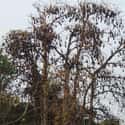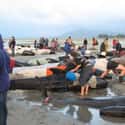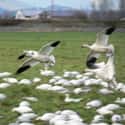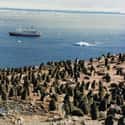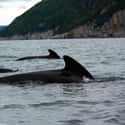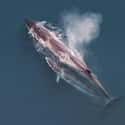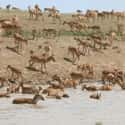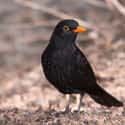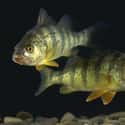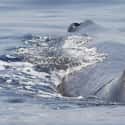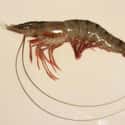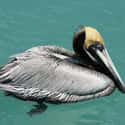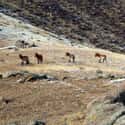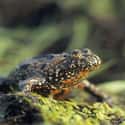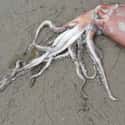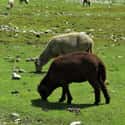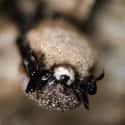-

(#1) More Than 400 Dead Seals Washed Ashore In Northern New England
Scientists think it may take as long as a week to figure out why so many dead seals are washing up in Maine https://t.co/sCMef7Ohvk
— CBS 21 News (@CBS21NEWS) August 19, 2018Starting August 12, 2018, an abnormal amount of dead or stranded seals started washing up on the shores of northern New England. Researchers were puzzled at first and did not understand what was causing such an influx in deaths. Over 400 seals' bodies found their ways on New England's beaches – primarily Maine's – over a span of three weeks, and after initial testing, researchers discovered many of them were infected with either avian influenza or phocine distemper virus. Still, scientists are not ruling other potential causes out.
"We have many more samples to process and analyze, so it is still too soon to determine if either or both of those viruses are the primary cause of the mortality event," said Jennifer Goebel, a spokesperson for the National Oceanic and Atmospheric Administration.
-
(#2) Thousands Of Fish Found Dead On A Texas Beach
In June 2017, thousands of dead fish mysteriously showed up on a Texas beach. The area is close to a river that feeds into the Gulf of Mexico. According to USA Today, the fish were menhadens, and died from unknown causes.
Some suspect it was the result of an algae bloom.
-
(#3) Hundreds Of Bats Cooked Alive In Australia After Brutal Heat Wave
At least 2,000 bats died after literally frying to death in a brutal heat wave. The bats - called flying foxes - were discovered in New South Wales, Australia. Temperatures hit 113 degress Fahrenheit in the region.
Members of the Wildlife Aid said it was the worst stress-related deaths they had seen in more than 10 years.
-
(#4) At Least 300 Whales Die After Beaching Themselves In New Zealand
At least 300 whales died and at least 100 more were left stranded after a pod of whales beached themselves off the coast of New Zealand. Volunteers helped to push some of the whales back out to sea, but said anywhere from 300 to 400 whales died.
Scientists are unsure why the whales beached themselves, but were able to save at least 50 of them - including the pod's matriarch.
-
(#5) More Than 80 Dolphins Beached Themselves Off Florida Coast
More than 80 false killer whales - members of the dolphin family - beached themselves off the South Florida coast in January 2017.
Of the group of 95 suspected to be stranded off the coast, 81 were discovered dead. Officials from the National Oceanic and Atmospheric Administration said 13 false killer whales are unaccounted for and one was seen swimming alive.
Scientists said this is the largest instance of whales beaching themselves in the state's history.
-
(#6) 2016 Snow Geesepocalpyse Of Montana Mine Country
In late November 2016, thousands of snow geese died in the acidic waters of an old mine pit in Montana. A flock of about 25,000 birds was forced to land in the mine when a snowstorm swept across the path of their migration. Since the landing, mine employees and other helpers have used flashlights and noise makers to scare the birds away and prevent others from landing.
According to those involved, these efforts have chased off the vast majority of the geese, though thousands died before they could escape. Mark Thomspon, a leader of the effort to get the geese out, described the mine as looking like “700 acres of white birds." He continued, “I can’t underscore enough how many birds were in the Butte area that night. Numbers beyond anything we’ve ever experienced in our 21 years of monitoring by several orders of magnitude.”
-
(#7) 2016 Reindeer Lightning Deaths
In August 2016, 323 reindeer in Norway were killed (apparently) by lightning all at once, in a bizarre and rare instance of an entire heard dying at once. Speaking to Verge, National Oceanic and Atmospheric Administration lightning expert Angela Chen explains how animals tend to group together during thunderstorms. With all the reindeer huddled in once place, it wouldn't be too hard for a single lightning bolt to kill them all through ground current, if the lightning made contact with the ground in the right spot.
A spokesperson for Norwegian Nature Inspectorate (NNI) noted it's unclear whether one lighting strike or multiple strikes in the same area killed the reindeer. "We’ve heard about animals being struck by lightning and killed, but I don’t remember hearing about lightning killing animals on this scale before," NNI spokesman Knut Nylend said.
-
(#8) 2016 Penguin Disaster
In early 2016, tens of thousands of Adélie penguins were cut off from their food supply by a stranded iceberg, leading to mass deaths. The iceberg, formally called B09B, has altered the colony's environment in Commonwealth Bay, Antarctica - a colony that once contained over 100,000 birds.
Now, numbers have dropped to a mere tenth of that once strong group, as the grounded iceberg fills the bay with ice, preventing access to the penguins' main food supply.
-
(#9) 2016 Indian Whale Stranding
In early 2016, dozens of pilot whales suddenly stranded themselves on a beach in southern India. While at least 45 died, many others were able to be guided back to the Indian Ocean. They were rescued by both local authorities and concerned fishermen, who went so far as to physically drag the whales off the beach and back into the water.
The cause of the stranding is unknown at this time.
-
(#10) 2015 Patagonia Whale Beaching
In December 2015, nearly 340 sei whales were found to have beached on the southern coast of Chile in a stranding that experts said was one of the largest they'd ever seen. The exact cause of the mass death was unknown, but the whales most likely died at sea and washed up, where aerial photography spotted their corpses.
While about three dozen whales were found in April, but the Chilean government opted not to investigate - leaving scientists to gather their own funds to further explore the remote beach.
-
(#11) Kazakhstan Antelope Deaths
Update, January 2018: In January 2018, researchers discovered that excessive heat was likely the cause of the bacterial infection that led to blood poisoning and internal bleeding. Scientists found that mass die offs historically occur in conjunction with warm and usually wet weather. However, the reason climate changes make saiga antelope more susceptible to illness and infection remains a mystery.
In late May and early June 2015, over 60,000 endangered saigas, a rare species of antelope, died in the Kazakhstan steppe. While animal die-offs are common on the steppe, the scope of this one, combined with the endangered status of the saiga, sent researchers into overdrive. The cause hasn't been determined, though the culprit was likely a combination of bacteria and environmental factors.
By November, 2015, the total estimated deaths was set at at least 211,000 – 88% of the antelopes in the Betpak-dala desert of Kazakhstan, and about 70% of the total population. The ultimate cause has still not been definitively determined.
-
(#12) 2011 Southern Blackbird Deaths
In January 2011, two mass die-offs of blackbirds hit two separate southern States, with thousands of the birds simply dropping dead out of the sky. Animal control scientists autopsied the birds and found evidence of violent trauma and internal injuries.
This indicates that they'd crashed into each other while flying in a tight formation, possibly after being disoriented by a storm.
-
(#13) Lake Erie Fish And Bird Kill
Researchers initially believed a lack of oxygen caused by a phenomenon called an inversion caused tens of thousands of fish to die and wash up on the shores of Lake Erie in 2012. Less explainable, however, is that a number of seagulls also died at the same time.
Not only that, but testing revealed no sign of an inversion, caused by unusual waves kicking up sediment and suffocating sea life. The cause of the die-off is still unknown.
-
(#14) Chilean Penguin Deaths
The Summer of 2009 was brutal for wildlife on the Chilean coast. Possibly the most unusual spate of deaths was the incident of 1,200 penguins that washed up dead on south Chile beaches over several days.
The die-off was blamed on everything from over-fishing to climate change
-
(#15) 2004 Ugandan Hippo Poisoning
In 2004, 300 hippopotamuses in Uganda's Queen Elizabeth National Park died in what park officials believe was a mass poisoning. The animals drank anthrax-contaminated water from stagnant pools, a frequent problem in dry areas hit by infrequent large rains.
Another die-off occurred a few days later, with nearly 100 hippos and buffalo died of anthrax poisoning.
-
(#16) Australian Whale Beaching
In 2008 and 2009, Australia was hit by four major whale beachings. involving nearly 400 pilot and sperm whales. Quickly moving scientists and volunteers managed to get a number of them back in the water, but dozens died, and the reason for the beaching remains unknown.
-
(#17) Chile Prawn Deaths
In March 2013, residents of a sleepy beach community in Chile were shocked to see a thick carpet of dead prawns. Local fisherman immediately pinned the blame on two new coal fired power plants heating up the water, but the power utility denied they had anything to do with the mystery. It remains unsolved.
-
(#18) 2009 Pelican Deaths
Hundreds of pelicans died or attempted to kill themselves in 2009, all up and down the west coast. Their strange behavior included wandering down streets and into traffic, crashing into cars and boats, hiding in yards, and beaching themselves. While many of the birds were saved, a number of them died.
The cause was thought to be a mysterious virus that affected the birds' judgement.
-
(#19) Mongolian Mass Die-Off
Mass animal deaths are so common in Mongolia that they have a word for it: zud. And the 2010 zud was likely the worst in the country's recorded history. A brutally hot and dry summer was followed by an unusually snowy winter - meaning the herd animals Mongolians depend on hadn't been able to properly graze in months.
Millions of sheep, horses, goats, cows, yaks, and sheep died. The UN estimated that up to 20% of the entire country's animal population didn't survive the 2010 zud. The reason this particular die-off was so bad is still unknown.
-
(#20) German Exploding Toads
A small pond in Hamburg, Germany became an abattoir for toads in 2005, when about 1,000 of the creatures died in one of the most gruesome ways possible - they exploded. Eye-witnesses claimed they swelled up to about three-and-a-half times their normal size and then simply popped, scattering their guts over several square meters. The cause was unknown for years, until one researcher determined it was crows pecking out the toads livers.
This caused the toads (who were caught up in their mating season) to puff up in self-defense. With nothing to hold their insides in, the toads couldn't stop puffing, and blew up. As to why the crows were pecking out the toad livers - that remains a mystery.
-
(#21) 2006 El Salvador Turtle Deaths
A bout of toxic algae (known as red tide) was found to be the culprit in a 2006 mass die-off of endangered sea turtles off the coast of El Salvador.
-
(#22) California Squid Beaching
The jumbo squid lives at a depth of over 2,000 feet - meaning it was perplexing as to why hundreds of the 6 foot long creatures beached themselves in California in 2005. What made this even stranger is that the squid weren't even normally seen in the area, leading researchers to speculate that they might have gotten lost..
A second beaching in 2012 was likely due to red tide poisoning
-
(#23) 2005 Turkish Sheep Jump
A herd of 1,500 sheep in rural Turkey suddenly decided to commit mass suicide, jumping off a nearby cliff for absolutely no reason. The first 400 died, but the rest survived - owing to the fact that they fell onto the bodies of their comrades. The reason for the jumping was never determined.
-
(#24) White-Nose Syndrome
Beginning in 2006 in New York, a mysterious fungus began causing millions of bat deaths all across the eastern US. The fungus doesn't kill the creatures, but it attacks them as they hibernate and prevents them from sleeping. The prematurely awakened bats leave their caves for food and burn up their body-fat reserves, freezing or starving to death.
Researchers believe they might have developed a cure, and have already used it on a small number of bats.
-
(#25) Switzerland Cow Suicides
While animals falling or jumping off cliffs is fairly common, an incident in rural Switzerland defied all explanation. Over three days, over two dozen cows individually made their way to the same spot over a cliff and walked off to their deaths. Even stranger is that animal experts generally believe cows aren't self-aware enough to commit suicide, meaning the deaths were accidental.
The cliff was so steep the bodies had to be pulled out via helicopter.
-
(#26) Cannery Row Sardine Crash
Sardines are a fickle fish, with boom and bust cycles common to wherever they live. It's not unusual for an area to be home to millions of sardines that mysteriously die and wash ashore. In the mid-40s, what's probably the most mysterious sardine crash in history happened in Monterey, California.
The Monterey Bay area was so dependent on sardine canning that it was known as Cannery Row. But in the aftermath of World War II-era overfishing, the population crashed didn't return for decades.
-
(#27) More Than 150 Pilot Whales Stranded Themselves On An Australia Beach
On March 22, 2018, over 150 pilot whales beached themselves on an Australian shore. A massive rescue effort went into effect immediately. Unfortunately, only six whales were returned to the ocean safely. Why did the whales intentionally beach themselves? There are a variety of theories.
Scientists believe that whales may accidentally beach themselves when following the leader of a pod. If a pod leader accidentally swims too close to shore, one whale could get beached and the others may follow. Environmental activists argue overuse of sonar technology may cause confusion for marine life, leading to mass beachings.
New Random Displays Display All By Ranking
About This Tool
In recent years, more and more cases of collective death of animals have occurred all over the world. For these phenomena, people can get many different explanations, such as disease, pollution, global warming, etc. It is quite strange in nature that a large number of animals die at the same time. Although scientific explanations can be found for many of these events, there are a few cases that cannot be explained.
It is clear that a decrease in the total number of animals may bring unpredictable and bad consequences to the earth's ecosystem, and may even threaten the survival of human beings. Mass animal deaths warned that the earth's ecological environment is already fragile, which is disturbing. The random tool lists 27 cases of mysterious mass animal deaths here.
Our data comes from Ranker, If you want to participate in the ranking of items displayed on this page, please click here.










